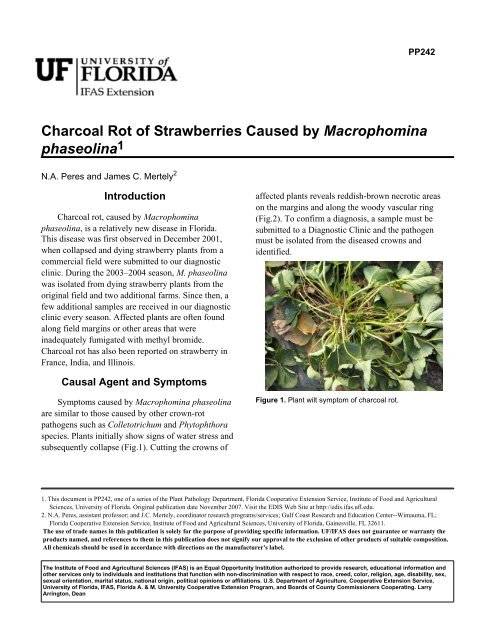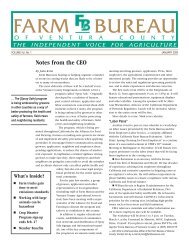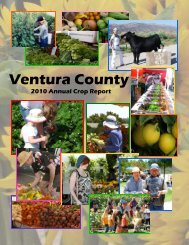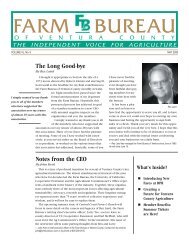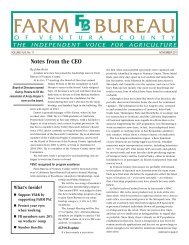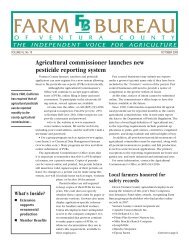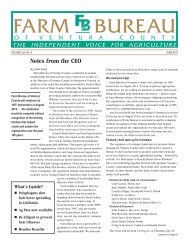Charcoal Rot of Strawberries Caused by Macrophomina phaseolina1
Charcoal Rot of Strawberries Caused by Macrophomina phaseolina1
Charcoal Rot of Strawberries Caused by Macrophomina phaseolina1
You also want an ePaper? Increase the reach of your titles
YUMPU automatically turns print PDFs into web optimized ePapers that Google loves.
PP242<strong>Charcoal</strong> <strong>Rot</strong> <strong>of</strong> <strong>Strawberries</strong> <strong>Caused</strong> <strong>by</strong> <strong>Macrophomina</strong>phaseolina 1N.A. Peres and James C. Mertely 2Introduction<strong>Charcoal</strong> rot, caused <strong>by</strong> <strong>Macrophomina</strong>phaseolina, is a relatively new disease in Florida.This disease was first observed in December 2001,when collapsed and dying strawberry plants from acommercial field were submitted to our diagnosticclinic. During the 2003–2004 season, M. phaseolinawas isolated from dying strawberry plants from theoriginal field and two additional farms. Since then, afew additional samples are received in our diagnosticclinic every season. Affected plants are <strong>of</strong>ten foundalong field margins or other areas that wereinadequately fumigated with methyl bromide.<strong>Charcoal</strong> rot has also been reported on strawberry inFrance, India, and Illinois.affected plants reveals reddish-brown necrotic areason the margins and along the woody vascular ring(Fig.2). To confirm a diagnosis, a sample must besubmitted to a Diagnostic Clinic and the pathogenmust be isolated from the diseased crowns andidentified.Causal Agent and SymptomsSymptoms caused <strong>by</strong> <strong>Macrophomina</strong> phaseolinaare similar to those caused <strong>by</strong> other crown-rotpathogens such as Colletotrichum and Phytophthoraspecies. Plants initially show signs <strong>of</strong> water stress andsubsequently collapse (Fig.1). Cutting the crowns <strong>of</strong>Figure 1. Plant wilt symptom <strong>of</strong> charcoal rot.1. This document is PP242, one <strong>of</strong> a series <strong>of</strong> the Plant Pathology Department, Florida Cooperative Extension Service, Institute <strong>of</strong> Food and AgriculturalSciences, University <strong>of</strong> Florida. Original publication date November 2007. Visit the EDIS Web Site at http://edis.ifas.ufl.edu.2. N.A. Peres, assistant pr<strong>of</strong>essor; and J.C. Mertely, coordinator research programs/services; Gulf Coast Research and Education Center--Wimauma, FL;Florida Cooperative Extension Service, Institute <strong>of</strong> Food and Agricultural Sciences, University <strong>of</strong> Florida, Gainesville, FL 32611.The use <strong>of</strong> trade names in this publication is solely for the purpose <strong>of</strong> providing specific information. UF/IFAS does not guarantee or warranty theproducts named, and references to them in this publication does not signify our approval to the exclusion <strong>of</strong> other products <strong>of</strong> suitable composition.All chemicals should be used in accordance with directions on the manufacturer's label.The Institute <strong>of</strong> Food and Agricultural Sciences (IFAS) is an Equal Opportunity Institution authorized to provide research, educational information andother services only to individuals and institutions that function with non-discrimination with respect to race, creed, color, religion, age, disability, sex,sexual orientation, marital status, national origin, political opinions or affiliations. U.S. Department <strong>of</strong> Agriculture, Cooperative Extension Service,University <strong>of</strong> Florida, IFAS, Florida A. & M. University Cooperative Extension Program, and Boards <strong>of</strong> County Commissioners Cooperating. LarryArrington, Dean
<strong>Charcoal</strong> <strong>Rot</strong> <strong>of</strong> <strong>Strawberries</strong> <strong>Caused</strong> <strong>by</strong> <strong>Macrophomina</strong> phaseolina 2Figure 2. Internal crown symptoms <strong>of</strong> charcoal rot.Disease Development and SpreadVery little is known regarding this disease onstrawberries. M. phaseolina is a common soilbornepathogen in many warm areas <strong>of</strong> the world and has avery broad host range. Many vegetable crops plantedas second crops after strawberry such as squash,cantaloupe, and peppers, legumes and others aresusceptible. Those infections may increase inoculumlevels <strong>of</strong> M. phaseolina in the soil in the <strong>of</strong>f season forstrawberries. In general, high temperatures and lowsoil moisture favor infection and disease development.ControlNo fungicides are labeled for control <strong>of</strong> charcoalrot on strawberries. Topsin M ® is labeled for control<strong>of</strong> charcoal rot on other crops. Our preliminary resultswith Topsin M ® have shown that application <strong>of</strong> thisproduct may delay onset <strong>of</strong> symptoms. Studies arecurrently being conducted to determine if cultivarsdiffer in susceptibility to charcoal rot. This diseasemay be an emerging threat as the Florida strawberryindustry makes the transition from methyl bromide toother fumigants.


